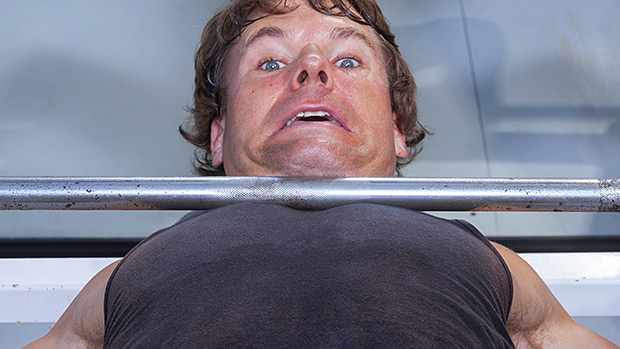A good spotter is an invaluable resource when it comes to pushing yourself to your limits. Someone who knows how to spot correctly will allow you to get the most out of each lift and will get you out of a jam if things go wrong.
But finding someone who knows how to spot correctly can be tough, so it's important to know how to properly buck the bar and bail out of bad lifts. If you find yourself in a facility without safety bars and still want to go heavy, use the tips below and learn to dump the bar like a pro.
It's easy to dump the bar on a front squat. If you feel your upper back start to round and your elbows drop to the point of no return, push the bar forward, let go, and step back. The chances of getting stuck under the bar on a front squat are slim since it's relatively easy to drop the weight forward.
The back squat can be terrifying if you find yourself unable to get out of the hole and stand back up. You can absolutely get crushed if you don't know how to bail.
If your squat goes south, you need to feel which way you're falling. Ideally you'll be able to keep your chest up and muster up enough strength to dump the bar backward. This is the safest way to get out.
If you're using the stretch reflex from the bottom position of the squat, and are using a high-bar position on your back, you should be able to come up just enough to dump the bar back and quickly step forward.
If you can't even begin to stand up, or you're using a low-bar position, you may need to dump the bar forward.
If you find your spine rounding, your chest dropping toward the ground, and all your weight shifting toward the front of your feet, you'll instinctively know which way the bar needs to go. This can be a shit-your-pants experience and you'll need to think fast.
To get out of this situation, you'll simultaneously need to duck your head and push the bar forward as you step back out from under the bar. The head duck is absolutely necessary to keep the bar from hitting the back of your noggin or neck. Pushing the bar forward with as much force as you can muster will also help you avoid getting smacked by the weight as you bail out.
When you're doing split squats, your torso is in a relatively upright position, which means your best bet will be dumping the bar backward. If you find yourself with your back knee pinned to the floor, you'll need to dump the bar back as you step forward with your front leg.
The best way to visualize this is to think of a wrestler shooting for takedown. Quickly slide your back knee along the floor as you "shoot" forward. Sliding out like this will help keep your rear leg low so the bar doesn't come crashing down on your lower leg.
If you're benching alone, keep the clips off the bar. If you have clips on the bar, you'll have to work the bar down the torso, but depending on how heavy it is, there's a good chance you may not have the strength to do that. Even if you do have the strength, rolling a heavy barbell over your chest, stomach, and hip bones doesn't exactly tickle.
Your best bet is to keep the clips off the bar so you can muster enough energy to slightly tilt the bar to one side. Doing this will allow gravity to slide the plates off of one side of the bar. Once this happens, the other side of the bar will come quickly down. All you have to do after this happens is pull the bar out of the plates and be embarrassed.
- In general, you shouldn't miss lifts. Missing lifts consistently can wreck your confidence and prevent you from becoming proficient with your technique. You need to be successful on the vast majority of your lifts to actually learn how to do a movement well.
- If you're going for a heavy set, make sure nobody's around you should you need to dump the bar. You don't want to be lifting something heavy and dump the bar right onto someone who's not paying attention.
- Nobody plans to fail, but people do fail to plan. If you've never practiced dumping the bar, your first time trying this should not be on a max attempt. If you need to dump the bar, you have to act quickly. Make a split second decision on how you'll escape. Keep yourself from getting injured by becoming comfortable escaping with a lighter weight before you actually need to use this skill.




